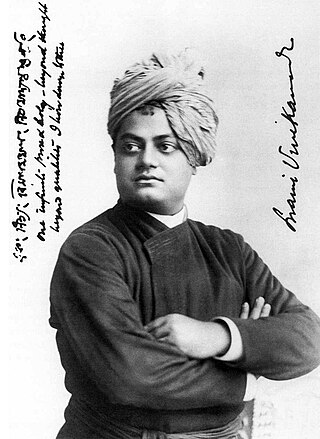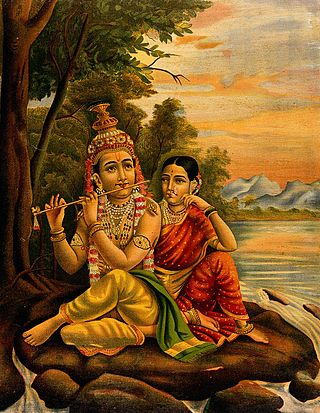
Swami Vivekananda, born Narendranath Datta was an Indian Hindu monk, philosopher, author, religious teacher, and the chief disciple of the Indian mystic Ramakrishna. He was a key figure in the introduction of Vedanta and Yoga to the Western world. He is credited with raising interfaith awareness and bringing Hinduism to the status of a major world religion in the late nineteenth century.

Advaita Vedanta is a Hindu tradition of textual exegesis and philosophy which states that jivatman, the individual experiencing self, is ultimately pure awareness mistakenly identified with body and the senses, and non-different from Ātman-Brahman, the highest Self or Reality. The term Advaita literally means "non-secondness", but is usually rendered as "nondualism", and often equated with monism. It rejects the Samkhya-dualism between Purusha, pure awareness or consciousness, and Prakriti as the two equal basic principles of existence. Instead, it proposes that Atman-Brahman alone is ultimately real, and, though unchanging, the cause and origin of the transient phenomenal world (prakriti). In this view, the jivatman or individual self is a mere reflection or limitation of singular Ātman in a multitude of apparent individual bodies. It regards the material world as an illusory appearance (maya) or "an unreal manifestation (vivarta) of Brahman," the latter as proposed by the 13th century scholar Prakasatman.
Rajanaka Kṣemarāja (क्षेमराज) was a philosopher disciple of Abhinavagupta, who was considered a master of tantra, yoga, poetics, and dramaturgy. Not much is known of Kṣemarāja's life or parentage. His chief disciple was a sage known as Yogāraja.

The Vivekachudamani is a philosophical treatise within the Advaita Vedanta tradition of Hinduism, traditionally attributed to the Vedāntic philosopher Adi Shankara, though this attribution has been questioned and mostly rejected by scholarship. It is in the form of a poem in the Shardula Vikridita metre.

Advaita Ashrama, Mayavati, is a branch of the Ramakrishna Math, founded on 19 March 1899 at the behest of Vivekananda, by his disciples James Henry Sevier, and Charlotte Sevier. Today it publishes the original writings of Vivekananda. As an ashram dedicated to the study and practice of Advaita Vedanta, no images or idols are worshipped there, not even of Ramakrishna; and no images were kept in the premises according to the Ashram ideals set by Vivekananda.

Swarupananda was a direct monastic disciple of Vivekananda and the first president of the Advaita Ashrama, set up by Vivekananda in 1899 at Mayavati, near Champawat. The ashram is a branch of the religious monastic order, Ramakrishna Math, also set up by Vivekananda on the teachings of his guru Ramakrishna.

The Advaita Guru-Paramparā is the traditional lineage (parampara) of divine, Vedic and historical teachers of Advaita Vedanta. It begins with the Daiva-paramparā, the gods; followed by the Ṛṣi-paramparā, the Vedic seers; and then the Mānava-paramparā, with the historical teachers Gaudapada and Adi Shankara, and four of Shankara's pupils. Of the five contemporary acharyas, the heads of the five Advaita mathas, four acharyas trace their lineage to those four pupils and one to Adi Shankara himself.

Swami Vivekananda was a Hindu monk from India. His teachings and philosophy are a reinterpretation and synthesis of various strands of Hindu thought, most notably classical yoga and Advaita Vedanta. He blended religion with nationalism, and applied this reinterpretation to various aspect's of education, faith, character building as well as social issues pertaining to India. His influence extended also to the west, and he was instrumental in introducing Yoga to the west.

Ānanda literally means bliss or happiness. In the Hindu Vedas, Upanishads and Bhagavad gita, ānanda signifies eternal bliss which accompanies the ending of the rebirth cycle. Those who renounce the fruits of their actions and submit themselves completely to the divine will, arrive at the final termination of the cyclical life process (saṃsāra) to enjoy eternal bliss (ānanda) in perfect union with the godhead. The tradition of seeking union with God through loving commitment is referred to as bhakti, or devotion.

Vedantasara, Essence of Vedanta, is a 15th-century Advaita vedanta text written by Sadananda Yogendra Saraswati.
Paramananda is a Sanskrit word composed of two words, parama and ānanda. Parama is taken to mean the highest or transcendent. Ānanda means bliss or happiness, and also suggests a deep-seated spiritual emotion that is entrenched. The Upanishadic authors also used ānanda, to denote Brahman, the Supreme Being in Hinduism.
Uparati is the ability to achieve "dispassion" and is a personal quality considered important in Advaita Vedanta in the pursuit of moksha. Uparati is a Sanskrit word literally meaning "cessation, quietism, stopping worldly action" and "discontinuation of religious ceremonies". According to the Vedic scholar Adi Shankara, Uparati or Uparama is the strict observance of one's own Dharma.
Bhuman (Sanskrit:भूमन) means fullness or abundance; It is a synonym of Brahman. The word, Bhuman, is derived from the word, Bahu, meaning much or many, with the suffix – imam, added after it by dropping – i, to impart the sense of the abstract noun. This word refers directly to the Supreme Self who is superior to Prana though Prana is Bhuman because of proximity where the vow of Prana, consisting in transcending all other thing is alluded to.
In Advaita Vedanta and Jnana Yoga Nididhyasana is profound and repeated meditation on the mahavakyas, great Upanishadic statements such as "That art Thou", to realize the identity of Atman and Brahman. It is the fourth step in the training of a sisya (disciple), consisting of preparatory practices, listening to the teachings as contained in the sruti, reflection on the teachings, and nididhyasana.

Charlotte Sevier, also known as Mrs Sevier, was a direct disciple of Swami Vivekananda and was British in origin. She, together with her husband James Henry Sevier established the Advaita Ashrama, a branch of the Ramakrishna Order, in Mayavati in the Himalayas.

Dhanraj Giri (1811–1901) was the abbot of Kailash Ashram, an ashram, which he established in 1880 at Muni Ki Reti, Rishikesh. It was one of the first large ashrams to be established in Rishikesh, prior to which it was mostly as a place for individual seekers, or pilgrims to stop over on way to Char Dham temples pilgrimage. He was a famous monk in Northern India and was a scholar in Vedanta philosophy. He was well acquainted with spiritual luminaries of nineteenth century India like Swami Vivekananda.
Kasaya is attachment to worldly objects and is an obstacle in the path leading to Nirvikalpa Samadhi: it is overcome through viveka, discrimination.
Rasāsvāda means – appreciation, sipping of juice, perception of pleasure; in Indian philosophy, it refers to the taste of bliss in the absence of all thought which is an obstacle in the path leading to Nirvikalpa Samādhi ; it is aesthetic consciousness. Rasasvada means one gets a power of healing or a power of knowing the mind which gives enjoyment but this enjoyment is superficial enjoyment or happiness which should not be sought while seeking Truth.
Aikyam means – oneness, unity, harmony, unanimity, identity or sameness or identical. The Upanishads address two fundamental ideas – Brahman and the Atman; as a rule these terms are used synonymously, there is no difference between these two. The main theme of Vedantic teaching is identity of the individual and the Total, that the self (Atman) and awareness (Chaitanya) are identical (aikyam). Aikyam means oneness or identity.
Viśayah primarily means – 'the sphere of influence or activity', and also refers to – 'dominion', 'kingdom', 'territory', 'country', 'abode', 'lands' etc., but in Hindu philosophy, it has been used to indicate 'the subject matter', 'the sense-objects', 'the subject of interpretation', 'the area or range of words' or 'the field of experience'. According to the Mimamsakas a complete adhikarana (अधिकरणम्) i.e. main, relation or connection, consists of viśayah (विषयः) - the subject or the matter to be explained, viśeya (विशय) or sanśeya (संशय) - the doubt or the question arising upon that matter, pūrvapakśa (पूर्वपक्ष) – the prima facie argument concerning it, uttarpakśa (उत्तर्पक्ष) or siddhanta (सिद्धान्त) – the answer or the demonstrated conclusion, and sangati (संगति) – pertinency or relevancy or the final conclusion. According to Srimad Bhagavatam (XI.ix.29), viśayah or the objects of sense enjoyment are to be found everywhere, as āhāra ('food'), nidrā ('sleep'), bhaya and maithuna.








